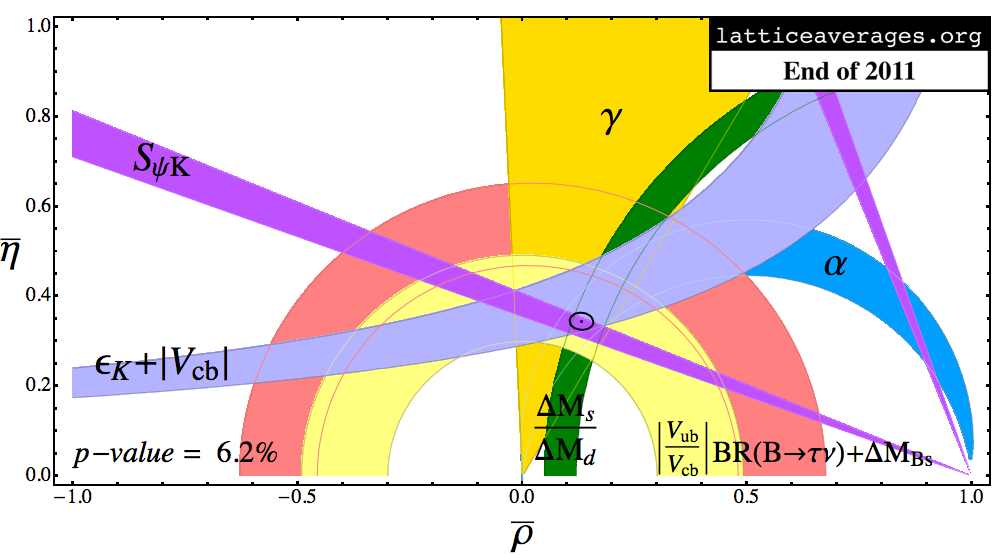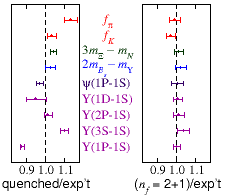
Lattice QCD calculations make possible constraints on the CKM matrix from K anti-K meson mixing
(light blue band), from
B anti-B and Bs anti-Bs mixing (green band), and from
B decay (yellow band).
Despite its extraordinary success, the Standard Model is believed to be
only the low energy (long distance) limit of a more fundamental theory.
Therefore, a major component of the experimental program in
physics is devoted to making precise tests of the Standard Model in order
to determine its range of validity and to search for indications
of new physics beyond it. Many of these tests require both
experiments and lattice QCD calculations of the effects of
the strong interactions on weak interaction processes. In almost all
cases, the precision of the tests are limited by the uncertainties in
the lattice calculations, rather than in the experiments. Our objective
is to bring the lattice errors down to, or below, the experimental ones.

Theory compared with experiment in the quenched approximation and in full QCD.

Shape of the form factor for the decay of a D meson into a kaon and leptons
predicted by lattice QCD (orange band) and measured by experiment (purple diamonds).
In the last decade, improved formulations of QCD on the lattice and the rapid growth in
the computing resources allowed the elimination of the one source of uncertainty in lattice calculation that had not been
systematically estimated : the full effects of vacuum polarization due to light
(up, down and strange) quarks.
This progress is illustrated
in the figure on the left in which the ratio of lattice results to experimental
results for a number of experimentally well determined quantities is plotted.
The panel on the left shows lattice results from the quenched approximation
in which vacuum polarization effects are neglected, while the panel on the
right shows lattice results for full QCD.
The lattice gauge theory community has moved from the validation of techniques
through the calculation of quantities that are well known experimentally to
the successful prediction of quantities that had not previously been measured.
Three cases in which predictions were subsequently confirmed by experiment
were the calculations of the leptonic decay constants of the D and Ds
mesons and the mass of the Bc meson. Another example was the successful
prediction of the form factor for the decay of the D meson into a K meson
and leptons, which is illustrated in the figure at the left. The orange band
is the lattice prediction and the blue plotting symbols are the results of
the Belle Collaboration.
In the last decade, lattice QCD calculations have played an increasingly essential role in determinations of a number of quantities crucial
to Standard Model tests, including amplitudes for the leptonic and
semi-leptonic decays of K, D, and B mesons, and the mixing of neutral K and B mesons with their anti-particles. The figure at the upper right shows determinations of the CP-violating parameters of the Standard Model, ρ and η, made from several different experimental inputs. In the Standard Model all determinations should produce the same results, but if beyond-the-Standard-Model effects are present different determinations need not agree. There is currently a greater than 2 σ tension in the best fit, indicating possible evidence for new physics. Precise lattice-QCD calculations, especially those of kaon and B-mixing matrix elements, played a key role in revealing this tension. Neutral kaon and B mixing have been measured experimentally to 0.5% accuracy, so there is enormous potential for sharpening the search for new physics in these processes with improved lattice-QCD calculations that are now underway.
New particles and forces could also be observed directly in collisions at the Large Hadron Collider at any time.
New challenges are likely to await us in new strongly interacting sectors in these theories, such as
dynamically broken supersymmetry, techicolor, or top-color. USQCD members are actively laying the foundations for investigation these new lattice gauge theories beyond QCD.
|

